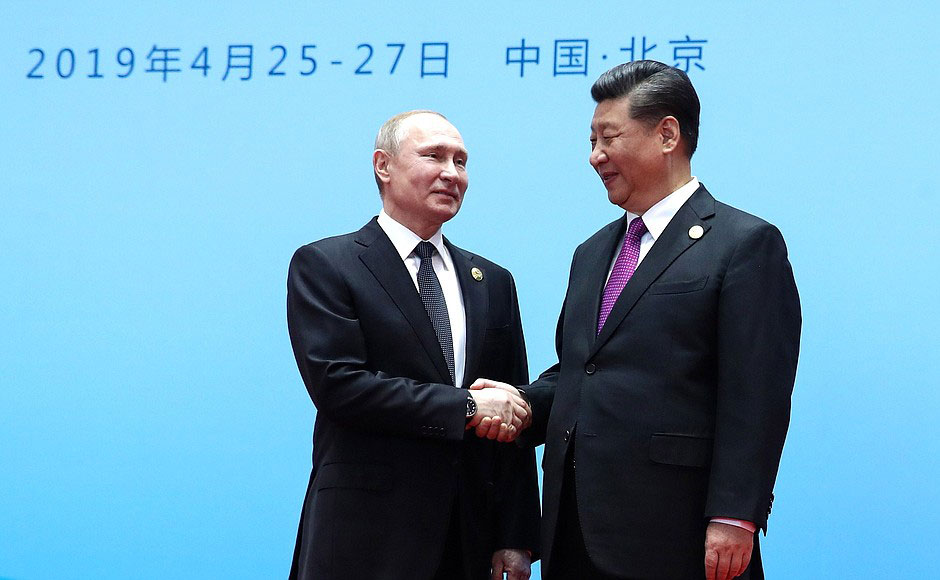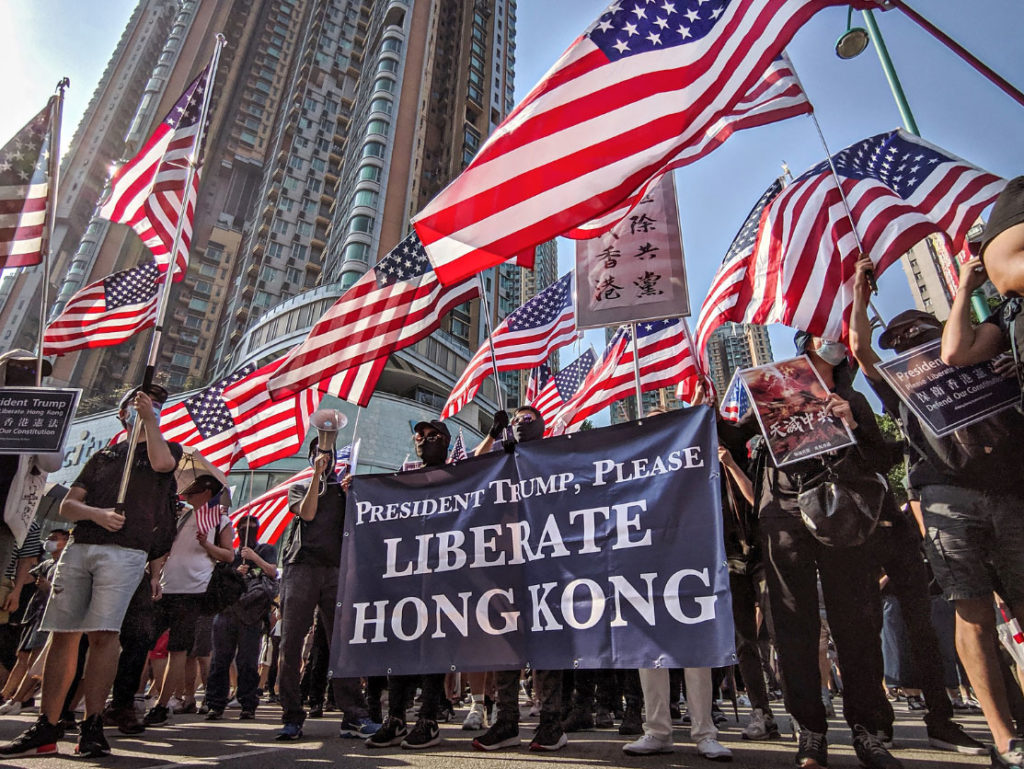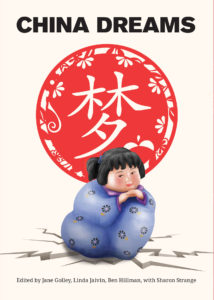
A pig lantern lights up the streets in Singapore for Chinese New Year celebrations in 2019
Source: Choo Yut Shing, Flickr
According to legend, the Jade Emperor called all twelve celestial animals to his palace to assign them their place in the zodiac. The Pig, a lazy if intelligent creature, was still in dreamland when the other eleven turned up to claim their places. He ended up last. And so 2019, the eventful Year of the Pig (coincidentally also marked by swine fever and a severe pork supply shortage in the mainland), ended a zodiac cycle that began with the Year of the Rat in 2008, the year of the Beijing Olympics — often referred to as the official ‘coming-out’ party of the People’s Republic of China (PRC).
By 2019, China had well and truly arrived. It boasted the second biggest economy in the world and could claim significant global influence and power. Yet the ongoing tit-for-tat trade war with the United States afflicted an economy already undergoing its own difficult internal readjustments — even if, by the year’s end, the two sides had signed a (precarious) ‘phase one’ of a peace deal. In Hong Kong, the nightmarish and increasingly violent cycles of protest, police suppression, and popular reaction that began with peaceful mass demonstrations in June showed no sign of abating. The US Congress infuriated the Chinese leadership by passing the Hong Kong Human Rights and Democracy Act and the Uyghur Human Rights Policy Act. While Beijing did its best to show a unified and defiant face to the world, three spectacular and unusual leaks of secret documents revealed the possibility of cracks beneath the surface of unity. These leaks included two tranches of documents concerning Xinjiang, one published by The New York Times and the other by the International Consortium of Investigative Journalists, as well as a collection of speeches made by China’s top leaders immediately following the events of 4 June 1989, in which they discussed what amounted to a playbook for dealing with future mass movements.
The Daoist philosopher Zhuangzi 莊子 once dreamed he was a butterfly. When he woke up, he realised he was just a man. Then he wondered whether he was not in fact a butterfly dreaming he was a man who had dreamed he was a butterfly. As Jingjing Chen writes in ‘Zhuangzi and His Butterfly Dream: The Etymology of Meng 夢’, the Chinese character for ‘dream’ (as seen on the cover) can be a metaphor for transformation.1 To speak of a dream in Chinese is also a common way of signifying nostalgia. The character meng has historically also been used to indicate the darker side of palace politics. It would later acquire, from the Western notion of ‘dreams’, the meaning of ideals and aspirations, as in the China Dream 中国梦. Dreams are also illusions, as in another of Chinese culture’s most famous dreams, The Dream of the Red Chamber (also translated as The Story of the Stone). Annie Luman Ren’s forum, ‘From the Land of Illusion to the Paradise of Truth’, looks at the relationship between reality and illusion in both the classic Qing dynasty novel and the ‘post-truth’ media in the contemporary Chinese world.
The year 2019 encompassed dreams in every one of these senses, from transformations to illusions and aspirations — and nightmares, too. When we sat down in February 2019 to plan this China Story Yearbook, it struck us how many significant anniversaries would occur over the course of the year — each representing a different kind of ‘Chinese dream’. These included the seventieth anniversary of the PRC — a dream of national revolution and renewal that, by the end of 2019, had become a dream of empire, with Xi Jinping’s proclamation of the ‘new frontier’ 新境界 of ‘Chinese rule’ 中国之治. Xi’s own power continued to grow in 2019 in both practical and symbolic ways. A set of ‘morality guidelines’ issued to all citizens in October not only defined the etiquette for singing the national anthem and the proper sorting of rubbish and recycling, but also called for all to ‘defend China’s honour abroad’ and adopt Xi Jinping Thought as their moral ‘core’. The guidelines made no mention of Mao or Deng Xiao-ping, unlike their last iteration in 2001. The Party also quietly eliminated a passage from literary Chinese textbooks that had been part of Chinese students’ education for decades, apparently for fear that its message of righteous rebellion might be taken too literally, as Esther Sunkyung Klein and Victor Fong write in ‘The Changing “Dream” in the Classroom: Literary Chinese Textbooks in the PRC’.
Another highly significant anniversary is that of the May Fourth Movement of 1919. As Gloria Davies discusses in ‘A Dream of Perpetual Rule’, the May Fourth Movement expanded from a patriotic protest into a movement encompassing workers’ and women’s rights, universal education, and cultural renewal. Xi Jinping, however, in what Davies calls an ‘ahistorical privileging of patriotism’, has narrowed its significance to its anti-imperialist beginnings while expanding it to endorse his own administration as drawing on its ‘powerful spiritual force’. She also makes the point that it is ‘perhaps more important to pay attention to what Xi’s China Dream does rather than what it means’.
The May Fourth Movement resonated deeply with the broad movement of pro-democracy petitioners and protesters in 1989 — a movement that ended in bloodshed when the Party ordered the army to open fire on 3–4 June that year. The thirtieth anniversary of those events, unlike that of May Fourth, cannot be publicly spoken of in China today. But all that happened on and around Tiananmen Square in 1989 has resonated strongly in Hong Kong from the beginning. Antony Dapiran, the author of a book on the Umbrella Movement of 2014, City of Protest: A Recent History of Dissent in Hong Kong, and the upcoming City on Fire: The Fight for Hong Kong, about the current protests, sums up and analyses the events of a chaotic year in Hong Kong in 2019 — a China story that is far from over, and one that continues to be a nightmare for many.
As Louisa Lim and Graeme Smith show in their chapter, ‘Hong Kong and the Tiananmen Playbook’, the Party’s reaction to the social and political unrest of three decades ago is a key piece in the puzzle of understanding its response to the upheavals in Hong Kong in 2019. The ‘Tiananmen Playbook’ also informs the Party-state’s actions in Xinjiang. China’s extreme repression of Uyghurs in the name of combatting ‘terrorism’ continued throughout 2019. Beijing heatedly denies the veracity of the leaked documents concerning the Party-state’s policies and practices in Xinjiang. Yet they provide a wealth of credible detail on the Party’s policies as well as rules for and conditions in the detention camps where perhaps a million or more Uyghurs and other Muslims are being held. Although the Party-state claims the detainees are receiving ‘vocational training’, the system appears designed to exterminate their cultural and religious identity. Enabling that is an ever-more sophisticated system of surveillance that, together with the evolving Social Credit System, has applications outside Xinjiang as well, as Gerry Groot writes in his chapter, ‘Schemes, Dreams and Nightmares: China’s Paradox(es) of Trust’. Samuel J. Parson delves into the ancient philosophical roots of these modern methods of control in ‘Legalism and the Social Credit System’.
Benjamin Penny, in ‘ “Evil Cults” and Holy Writ’, notes another anniversary. It has been twenty years since Falun Gong adherents shocked the Party leadership by successfully surrounding its headquarters at Zhongnanhai in silent protest. While the Falun Gong remains outlawed in China today, Penny explains why the Party-state is currently even more worried about another religion on its official list of ‘evil cults’: the millenarian Church of Almighty God. Ben Hillman reflects on the second year of the Party’s campaign to Sweep Away Black and Eliminate Evil 扫黑除恶, which promises to build a more harmonious society by taking down undesirable elements, including gangsters, local tyrants, and corrupt officials. The Party is also using the campaign as a tool of wider social control.
Another anniversary is that of the flight of the Dalai Lama from Tibet in 1959 following a Tibetan uprising against Chinese rule. Han migration, strict policing, and surveillance, as well as targeted investment, have radically changed the face of Tibet over the intervening sixty years. One major change has been rapid urbanisation. In their chapter on ‘Urbanising Tibet: Aspirations, Illusions, and Nightmares’, Gerald Roche, James Leibold, and Ben Hillman examine what young Tibetans’ hopes and fears are about the changing world around them and city life, as revealed through three Tibetan pop songs.
Still in the borderlands, in ‘ “Prairie Mothers” and Shanghai Orphans’, Uchralt Otede unearths a forgotten piece of history behind Xi Jinping’s award of the honorary title of People’s Model to a 77-year-old Mongolian woman for her role in relocating thousands of Shanghai orphans and abandoned children to Inner Mongolia during the Great Leap Forward era six decades ago. Jane Brophy’s Forum about two Inner Mongolians infected with the plague being mysteriously ‘transported’ to a Beijing hospital in November evokes a recurring nightmare with historical, environmental, and authoritarian dimensions. The foreboding story presages the outbreak of the coronavirus epidemic in the city of Wuhan in January 2020.
The dreams of Taiwan’s LGBTQ community came true in 2019 when Taiwan became the first place in Asia to legitimise gay marriage. In ‘Queer Dreams’, Jamie Zhao also surveys legal changes in the mainland that may signal shifting attitudes there as well.
The May Fourth Movement advocated for ‘Mr D’ (democracy) and ‘Mr S’ (science). If Mr D had a difficult time in 2019, Mr S fared better. A number of pieces in the Yearbook survey Chinese dreams and accomplishments in science and technology, including China’s emerging dominance in some sectors — and some of the controversies this has engendered. Adam Ni looks at how private entrepreneurs are working with state bodies to realise China’s ‘space dreams’. In ‘Dream Babies’, Jane Brophy discusses the Chinese scientist who — horrifying many in the international scientific community for his violation of international ethical standards — helped bring to term the world’s first genetically modified babies. Darren Lim and Victor Ferguson tackle the tricky topic of Huawei and the Sino–US trade war in ‘Conscious Decoupling: The Technology Security Dilemma’. Olivia Shen, in ‘AI Dreams and Authoritarian Nightmares’, writes about the implications of China’s ambitious plan to lead the world in the theory and technological application of artificial intelligence (AI) and to become the global centre for AI innovation by 2030.
Abroad, the footsteps of the China Dream continued to grow in 2019, including through the ever-expanding Belt and Road Initiative. But anti-China sentiment was also rising. This is partly due to revulsion at the state’s actions in Xinjiang and sympathy for the demands (if not always the methods) of the Hong Kong protesters, and partly due to the discomfort of many in the West at the prospect of a powerful China rewriting the rules of the ‘rules-based order’. Such issues as whether Huawei should run 5G networks in other countries continue to create problems and tensions. Arrests of more than a dozen Canadian citizens in retaliation for Canada’s detention of Huawei executive Meng Wanzhou 孟晚舟 for extradition to the United States, has badly strained once-friendly Sino–Canadian relations. Elsewhere, it is the footprint of the China Dream itself that feels heavy: in ‘South Korea and the “China Effect” ’, Hyung-Geun Kim discusses the choices and challenges faced by South Koreans with regard to the Belt and Road Initiative, and Chiung-Chiu Huang, in ‘Taiwanese Dreams: Security, Sovereignty, and the Space to be Seen’, delivers a Taiwanese perspective. Beyongo Mukete Dynamic, meanwhile, casts a cool eye on China’s Antarctic dreams in ‘Antarctic Ambitions: Cold Power’. Richard Rigby and Brendan Taylor look at the big picture in their chapter, ‘Meridians of Influence in a Nervous World’. Finally, in ‘Campus Conundrums: Clashes and Collaborations’, Jane Golley, Paul Harris, and James Laurenceson examine the situation on Australian university campuses, which were front and centre in news stories about Chinese influence and interference throughout the year.

Vladimir Putin and Xi Jinping at the 2019 Belt and Road Forum for International Cooperation
Source: TASS,
President of Russia
In thinking about the lessons of the year, we return to another of China’s most famous dreams, the Golden Millet Dream 黄粱梦. In it, a young scholar — poor, unmarried, and having just failed the imperial examinations in Beijing — arrives at a small inn, feeling very sorry for himself. He meets a Daoist priest there, who urges him to sleep, and gives him a special pillow. As the scholar falls into a deep sleep, the innkeeper is cooking a pot of golden millet for lunch. In his dream, the young scholar marries a beautiful woman from a noble family. He passes his examinations and becomes a high official and enjoys great wealth. He and his wife have five sons, all of whom become high officials, marry well, and give him many grandsons. He lives a long and fulfilling life, though there are dramas and tragedies as well. At the age of eighty, he becomes ill but just as he is about to take his dying breath, he opens his eyes and realises he is back in the inn and the millet is still cooking. Only a short time has passed. The Daoist priest is still sitting by his side. ‘Was that really just a dream?’, the young scholar asks. The Daoist replies that wealth and glory and all the rest are but illusions, and all things pass.
Acknowledgements
The China Story Yearbook is a project initiated by the Australian Centre on China in the World (CIW) at The Australian National University (ANU). It has always been the approach of the Yearbook to view political and economic developments as part of a greater picture that encompasses society, personalities, and culture, and one that is illuminated by considerations of language and history. Our ongoing reference to the China Story 中国的故事 reflects the principle set out by CIW Founding Director, Emeritus Professor Geremie R. Barmé, that China’s story is not only the version portrayed by the Chinese Communist Party, but also includes the diverse perspectives of a multitude of others, within and outside the PRC.
Many of the subjects we cover in this year’s China Story Yearbook are topical in ways we could not have anticipated when we first began commissioning the contributions in mid-2019. Co-editors Jane Golley, Linda Jaivin, Ben Hillman, and Sharon Strange are enormously grateful to all the wonderful scholars and other contributors, new and old, who have taken the theme of dreams and applied their unique knowledge, insight, and observation to come up with another great collection of essays that we are proud to publish. The China Story Yearbook is truly a collaborative effort. We also thank Chin-Jie Melodie Liu for her assistance with typesetting the book, Jan Borrie for copyediting the book, and two anonymous referees for taking the time to read and comment on it prior to publication, as well as our designers from CRE8IVE, Laura Sibley and Josh Garrard.
The Cover Image
The character at the centre of this Yearbook’s cover is meng 梦 (夢 in traditional characters). Readings of this character have changed from early references to dimness, gloominess, and even chaos in an obscure environment, to a metaphor for a forever-lost life (and its material pleasures). Since 2013, however, the character has been used in the phrase the ‘China Dream’ 中国梦. That was the inspiration for this Yearbook’s English title, China Dreams. The concept of the China Dream was first coined by Xi Jinping. It describes a set of personal and national ideals. The phrase is a loan translation: it follows the rendering of the ‘American Dream’ as Meiguo meng 美国梦. For more information on the etymology of meng, see the Introduction Forum ‘Zhuangzi and His Butterfly Dream: The Etymology of Meng 夢’, pp.11–14.
The large red circle that encompasses the character meng echoes the aesthetics of traditional Chinese paper-cutting 剪纸. Present throughout China, paper-cutting is a popular art integral to everyday lives. Designs vary greatly and adopt a range of regional styles. They are used for interior decor, festivities, or prayer.
The girl on the front cover is the China Dream girl. She is a clay figurine nirenzhang, 泥人张. She was the main image of the Chinese Communist Party propaganda campaign used to promote the China Dream in the early 2010s. She regularly appeared on government billboards with the phrase: ‘The China Dream, My Dream’ 中国梦, 我的梦. With an innocent expression and flushed cheeks, she presented the campaign’s most human vision of the dream.





